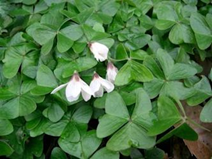"Oxalic Acid"
Topics Beekeepers Can't Agree On!
By: Lynne Jones
As detailed in previous articles in this month’s issue - Varroa mites are a serious problem, and we are all faced with the responsibility to control them. Control methods range from hard chemicals, regular requeening with VSH stock, to screened bottom boards and culling drone comb.
What is more important than the method(s) you choose, is to choose and do. Some treatments and methods are more effective than others, and some more labor intensive than others. Choose and do – and if it doesn’t end up being a good choice for you and your bees, choose and do something else!
One of several “soft” chemical options is Oxalic Acid (OA). Oxalic acid is an organic acid found in the common weed Oxalis, aka wood sorrel. It is also found in many edible plants including spinach, rhubarb, and kale, and even found to be a component of honey! The use of OA for treating Varroa mites is considered an organic or natural treatment and approved by the EPA.
Oxalic Acid can be applied in three ways: mist, sublimation (referred to as oxalic acid vapor or OAV), or by drip/dribble. The mist application is only approved for caged bee use (typically package of bees);
but for bee removers – a wired bee vac container would also be considered caged. The other two methods – OAV and Dribble are used for bees in hives. OA is very effective when brood is not present; but it can still be used with brood present, but it just won’t be as effective. For the most part, in Texas we don’t have broodless periods. At best we have periods with less brood, so don’t let the “broodless” aspect dissuade you from using OA.


Like all options, OA Dribble has its pros and cons.
Pros
- Easy to apply
- Very inexpensive Organic
- Not lipid (fat) soluble and will not build up in wax comb
- 70 times as toxic to mites as it is to adult bees.
- Can be used in hot weather
- Now approved for use with honey supers on
- Can be very effective (depending on the amount of capped brood)
Cons
- For “summer treatment” when brood is present, it must be applied three times at six-day intervals. (Winter treatment is only applied once!).
- There is some bee and brood mortality, but minimal when directions are followed precisely.
- It may reduce the queen’s lifespan.
- Not as effective with brood present
How to apply an oxalic acid dribble, is a good article on the basics of the Dribble method and I encourage you to read it before trying this method yourself. The article is on Rusty Burlew’s blog, Honey Bee Suite.com
For an excellent list of safety recommendations and formulas for making the solution, click on the image below - Randy Oliver - ScientificBeekeeping.com

Once your solution is prepared, fill a 60-cc syringe with 50-cc of OA solution. Practice with the syringe by dribbling evenly back into the container and noting each 5 ml mark. Personal Tip: I have trouble applying only 5 ml using the large syringe and instead use ten of the smaller 6-cc syringes per hive, filling each to the 5-cc mark. It is a little more cumbersome, but it’s what works best for me.
The maximum treatment per hive is 50 ml. Since you are only treating one box of the hive, smoke the bees into the bottom box so you can apply the solution to as many bees as possible. The goal is to apply only 5 ml per ‘seam’ of bees. For the two outside seams, divide 5 ml between them.
Like every treatment option, OA has its pros and cons, and vapor is more effective than dribble. If you are having trouble deciding on what method of Varroa control to use, consider giving OA Dribble a try.


Items needed:
- Plastic bowl or container
- Oxalic Acid
- Distilled water (if your water is high in calcium)
- Measuring cup with “ML” measurements (for making 20 hive quantity) Eye protection
- Gloves
- 60-cc syringe
- Scale that weighs in Grams


